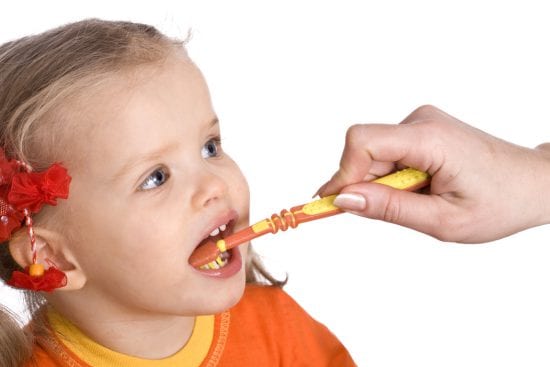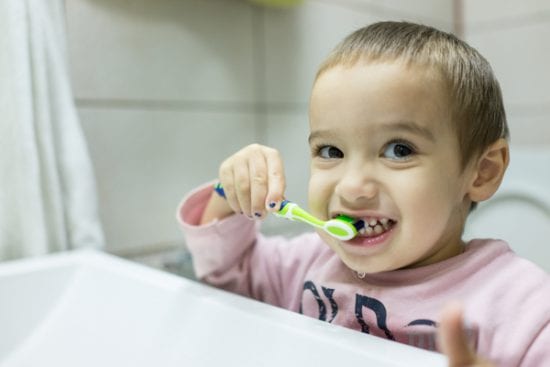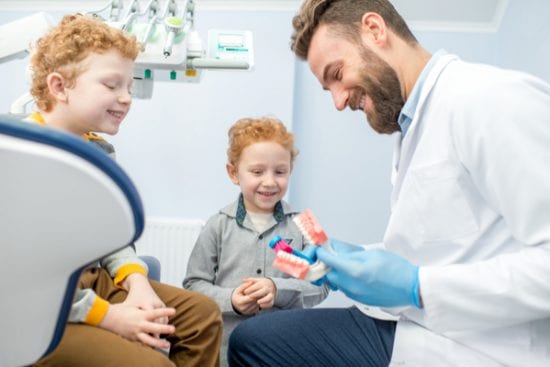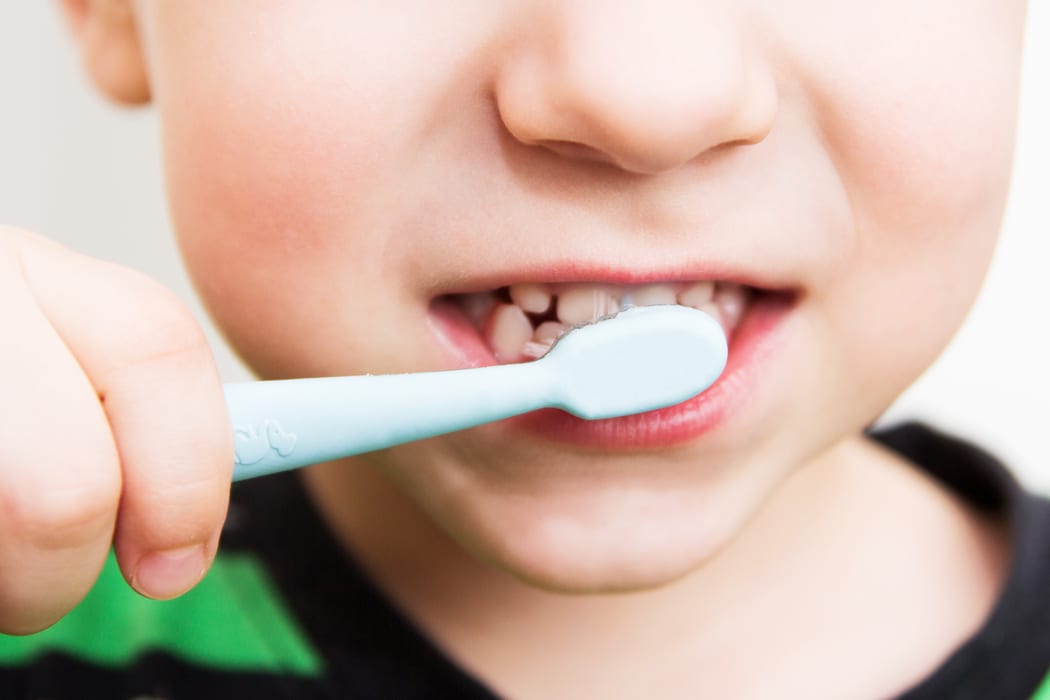How should kids brush their teeth and when should they begin? The simple answer is that the minute that first pearly white tooth pops out of your baby’s gums, it’s time to begin brushing. At first, use a very soft brush and some water. Later on, at around 18 months, use a pea-sized glob of fluoride toothpaste. After the age of seven, children can be trusted to brush their own teeth, with a bit of supervision from parents.
No parent can doubt the importance of a child’s teeth. Teeth help children eat and speak and support the bones in their faces so they look nice. But teeth don’t take care of themselves. If children don’t brush their teeth, plaque can form in a thin coating on the teeth. Plaque (PLACK), is a sticky, thin film of bacteria that attaches itself to the teeth.
The preferred food of the bacteria in plaque is sugar. That may be the sugar in a piece of candy or a glass of soda pop, or it may be the sugars that develop from the carbohydrates we eat, for instance noodles, grains, and potatoes. Any time children eat starchy or sweet carbohydrates, they feed the bacteria on their teeth. As bacteria interact with starches and sugars, they turn into acids. These acids burn their way through children’s tooth enamel, making the holes in their teeth that we call cavities.

Brush Their Teeth: Gums, Too!
The bacteria in children’s mouths don’t just cause cavities. They also attack children’s gums. If kids don’t brush to remove the bacteria-filled plaque in their mouths, they may end up with gingivitis (jin-ja-VIE-tis), or gum disease. Gum disease not only looks and feels bad, giving children sore, swollen, red gums, but can also cause tooth loss. Gums, after all, are the tissues that hold and support the teeth inside the mouth.
Children should brush their teeth twice a day, after eating breakfast and again before bed. It doesn’t hurt to brush after lunch and after having a snack, too. It is brushing the teeth that removes plaque from children’s teeth, keeping them and their gums, healthy.

All of the teeth should be brushed, and not just those in the front. If children can think of their mouths as having four parts or quadrants, it makes it easier to cover all of them. Spend 30 seconds brushing each section of the mouth, beginning at the back and working toward the front, front and back of each section, gums and teeth, for a total of two minutes of brushing altogether.
Angle the brush 45 degree toward the gums from the upper and lower teeth. Move the brush back and forth using short strokes along teeth and gums, making sure to cover all the teeth and gums, front and back. Make sure the tip of the brush is upright when brushing behind the front teeth, both top and bottom.
Don’t forget to brush the tongue, too! Plaque sticks to tongues as well as teeth.
Brush Their Teeth: Two Minutes
It can help to play a 2-minute song as children brush, or to have them sing one in their heads. When the song is over, they’re done brushing! Alternatively, parents can use a two-minute hourglass to help children keep track of how long they should brush their teeth. Some battery-operated or electric toothbrushes have a built-in timer, and will vibrate when it’s time for the child to move along to the next quadrant.
Make sure to use a toothbrush with soft bristles. Get a new one every three months. Some toothbrushes have bristles that turn pale when it’s time to change to a new brush.
If children become sick with a cold or the flu, buy a new toothbrush once the child is recovered. It’s a good idea to have several spare soft-bristled toothbrushes on hand in the home for this purpose. Buy a bunch when they go on sale.
Brush Their Teeth: Floss ‘Em, Too!
Floss your child’s teeth as soon as there are two teeth that touch. Do this once a day. Slip the floss between the teeth to remove food that gets trapped between the teeth, where a toothbrush cannot reach.
To floss, take a strand of floss between thumb and index finger, wrapping the floss around a finger at each end of the strand for good control. Insert the floss gently and curve it around each tooth, sliding it up and down along the insides of the teeth and just below the gum line. Use a new section of the floss for each two teeth, so as not to transfer plaque from one tooth to the next.
Even when children do a great job brushing and flossing, it’s important to have their teeth cleaned by a dental hygienist (hi-JEN- 7i ist) or dentist twice a year. A professional cleaning gets the plaque we might miss, even with the best of efforts. The dentist or hygienist can also give children tips on better techniques to use when they brush their teeth.

Limit sweets and starches to starve plaque of its favorite source of nourishment!
Brush Their Teeth: Water or Toothpaste?
You can begin using fluoride toothpaste for a child of 18 months, using a pea-sized dab on a water-dampened soft-bristled toothbrush. Children should be cautioned not to swallow toothpaste when brushing. Make sure that children spit the foamy mess of toothpaste and loosened plaque out into the sink.
Children can rinse their mouths out with water, after they brush0 their teeth. This gives them more practice at spitting!
Brush Their Teeth: Infants
An infant’s teeth should be brushed with a soft-bristled toothbrush moistened with water.
For an infant or very young child, hold the child in your lap, facing away from you, or stand behind a young child. The head should be tilted back so you can see the teeth. Brush their teeth gently with a circular motion, angling the bristles toward the gums.

It’s important to make tooth-brushing a fun time for parent and child, in order to avoid a situation where the child fusses and fights when it comes time to brush their teeth. You want the child to develop good dental hygiene habits right from the beginning. That’s the best way to prevent painful cavities and expensive dental work.
Let your child see you brushing your own teeth, night and day. Doing so sends a message to your child that this is something that everyone does and that it’s important.
Brush Their Teeth: Make it Fun!
Make tooth-brushing a fun time by gargling noisily or trying to sing songs as children brush their teeth. Roll your eyes and make faces at your child as the two of you brush your teeth together! Tell jokes. Do whatever you can to reinforce the idea that brushing teeth is fun and represents quality parent-child time.
Think of keeping your child’s teeth clean as having the same importance as wearing a seat belt in a car, or putting on sunscreen. If you feel this way, your child will come to feel this way, too.
If you can’t find a toothpaste your child likes, have children brush their teeth with plain water. Your child will still get the benefits of brushing.
How do you make brushing fun?
How do you keep kids from fussing at tooth-brushing time?

If dental health is taken care of from the starting, one can easily deal with future dental issues. I really like what you have shared here about at what time kids should start brushing and the correct procedure. Brushing their teeth in fun way was a good idea. Thanks.
Children dentist Julington Creek Florida